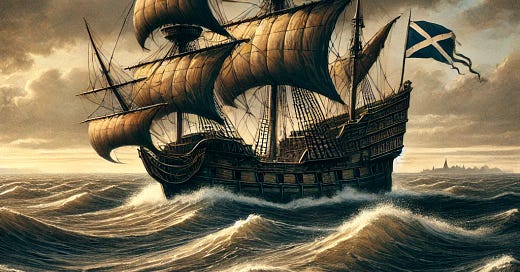The port of Glasgow in the 17th century didn’t smell of glory or gunpowder. It reeked of fish oil, tar, and ambition. This was a city just beginning to shrug off its medieval identity, casting its eyes toward the Atlantic, hungry for trade, prosperity—and, at times, plunder. In the decades following the Restoration of the monarchy in 1660, Glasgow's merchants weren’t just traders and shipbuilders. Some of them became something else entirely: privateers, legally sanctioned pirates who sailed under a commission to attack the enemies of the Crown—most notably, the Dutch.
This isn’t the kind of story that often gets told in prim civic histories or university brochures. But it’s a vivid one, full of swagger, salt, and steel, and it reveals how deeply Glasgow’s global ambitions were tied to both commerce and conflict.
The Dutch Rivalry and the Rise of Privateering
To understand how respectable Glaswegian merchants became privateers, you need to understand who the Dutch were to 17th-century Scotland. By the mid-1600s, the Dutch Republic was the world’s leading naval and commercial power, commanding vast trading empires from Java to the Caribbean. Their ships filled Europe’s harbors, including the Scottish ports that lay within reach of the North Sea.
The Dutch also controlled lucrative routes and goods that Scottish traders desperately wanted a piece of. In the aftermath of the English Civil War and Cromwell’s Commonwealth, and especially after the Restoration of Charles II in 1660, Scotland found itself politically re-aligned but economically stifled. English ports dominated domestic trade, and Glasgow's merchants, chafing at trade restrictions and keen to carve out their own markets, found themselves increasingly frustrated.
Enter privateering. It was a perfectly legal form of piracy, provided the pirate in question had a “letter of marque”—a document issued by the Crown allowing them to attack enemy ships and seize cargo as spoils of war. During the Anglo-Dutch Wars (a series of naval conflicts between England and the Dutch Republic between 1652 and 1674), these commissions were handed out freely. And Glaswegians, always quick to spot an opportunity, took to the seas.
Clyde-Born Corsairs: Glasgow’s Sea Raiders
By the late 1660s, Glasgow was no longer a sleepy bishop’s city. Its mercantile community had grown in wealth, audacity, and maritime skill. Though the city was still using Irvine as its seaport, it was well on its way to developing its own shipping base along the Clyde. And from there, a handful of bold merchant-captains set sail—not just to trade, but to hunt.
These privateers weren’t ragtag buccaneers in the Caribbean. They were wealthy investors, shipowners, and traders who fitted out ships with guns and sailors and headed into the North Sea and beyond. When they intercepted Dutch merchant ships—laden with spices, wool, wine, sugar, or coins—they would capture the vessel, bring it back to port, and have it condemned in a local court, which would allow them to sell the prize and split the profits.
It was risky business, of course. Not only were there storms and cannonballs to worry about, but the Dutch had formidable warships and privateers of their own. Many Glaswegian ships didn’t return.
One prominent name associated with this era is Walter Gibson, later Provost of Glasgow in 1688, a man who was as much a capitalist as he was a civic leader. While no explicit record pins him as a privateer, Gibson’s wealth and influence were deeply tied to maritime ventures, including fishing, shipbuilding, and trading voyages to France and beyond—ventures that overlapped suspiciously with periods of war and plunder. He belonged to the same merchant class that sponsored and profited from privateering.
Legal Piracy or Ruthless Theft? The Ethical Grey Zone
Privateering wasn’t piracy—at least not officially. But in practice, the line was as thin as a sailcloth thread. A ship with a crown-issued letter of marque might one day be seizing “enemy” cargo on the high seas—and the next, attacking a neutral or even allied vessel under murky pretense.
Scottish ports, especially smaller ones like Port Glasgow, could become safe havens for contraband. Stolen goods were offloaded quietly and laundered through networks of traders and sympathetic customs officials. Some merchants grew suspiciously rich, even as official trade remained modest.
The Crown, for its part, benefited too. It got a cut of all privateering profits, and the harassment of Dutch shipping helped weaken a rival empire. Everyone, it seemed, had a stake in the venture—except, of course, the Dutch sailors who found themselves imprisoned, or worse, when Glaswegian cannonballs tore through their hulls.
Legacy on the Clyde: Pirates, Port Cities, and Global Dreams
By the early 18th century, the wars with the Dutch had cooled, and with the Union of 1707, Scotland gained full access to England’s colonial markets. Privateering faded in importance, replaced by more conventional—and more profitable—forms of trade. Glasgow turned from pirate outpost to powerhouse, shipping tobacco, sugar, and cotton from the Americas, and importing tea, porcelain, and textiles from the Far East.
But the shadow of privateering lingered. It shaped how Glasgow saw itself—not just as a city of faith and learning, but as a city of enterprise, risk, and resilience. The same boldness that sent merchants to sea with letters of marque would later fuel industrial revolutions, transatlantic empires, and a global legacy.
Today, you won’t find a plaque commemorating Glasgow’s privateers. The story has been mostly swallowed by history—overshadowed by the grandeur of shipyards and the achievements of Victorian engineers. But the privateers were the forerunners, the ones who tested the water, quite literally, for what Glasgow could become.
In the spray of the Clyde and the quiet of forgotten harbors, their story is still there. A reminder that once, not so long ago, merchants from this grey stone city hoisted sails not just for trade—but for war.





